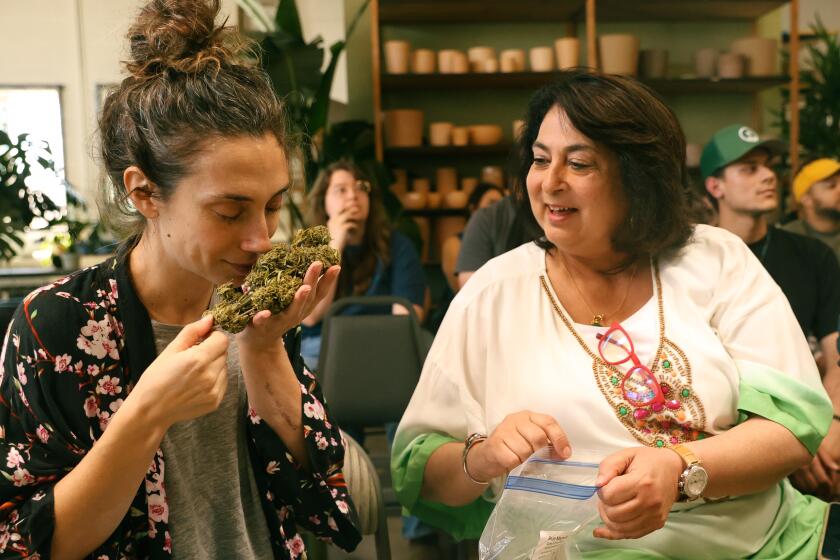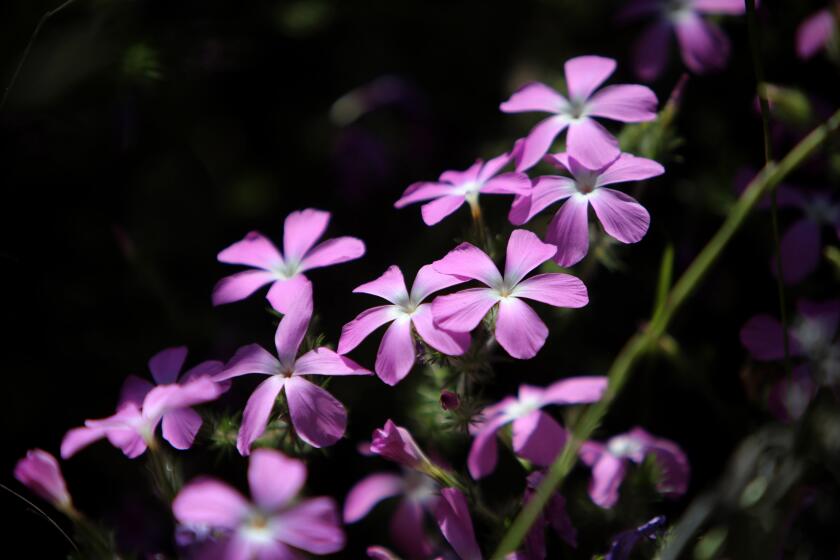They Can Dig It : Leisure World’s Garden Plots Thicken With Grapes, Squash, Beans, Corn . . .
The grapes are practically dripping off the vines in Edward Griswold’s garden in Leisure World. Nearby, boysenberries are ripening, tomatoes are reddening and Brussels sprouts are, well, sprouting.
It’s the tenth summer harvest for Griswold’s garden. Griswold, 68, a semi-retired inventor who grew up on a farm in Alhambra, sought a spot of soil to till in the community gardens soon after moving into Leisure World in 1979.
“I had to keep my hands dusty,” he said with a smile.
This is the season of plenty at the two garden centers in the heart of the Laguna Hills retirement community. The fertile land, most of it divided into plots of 10 feet by 20 feet, is fragrant with the scent of tomato these days, and one can practically see the corn and zucchini growing.
Some 550 senior citizens there look to the community gardens for a chance to exercise their green thumbs, as the postage-stamp-size yards and porches in their co-ops and condominiums don’t allow much room for gardening. They spend a few hours each day watering the soil, propping up the burgeoning tomato plants and bean vines and harvesting the fruits--and vegetables--of their labor.
“I had a zucchini that was 4 inches long. I was gone for five days, and when I came back it was 5 pounds,” said Les Dubin, a retired photoengraver who also raises tomatoes, green beans, cucumbers, beets and garlic, and has just started grapevines.
Dubin’s bountiful yield is not unusual. Many of the gardeners grow more than they can eat, so there’s plenty of swapping going on. Dubin’s oversize squash went to another gardener, who gave him a bag of home-grown potatoes in return.
“It’s great therapy, great recreation, and it helps them supplement their food supply as well,” said Deborah Lamb, Leisure World recreation director.
Many of the residents had lived in homes with large yards and were accustomed to gardening, Lamb said, but they are discouraged from doing that on their Leisure World property. Plants can attract bugs, and spraying pesticides is dangerous in such close quarters.
So the gardens are in demand. The first, a 6-acre strip of 400 lovingly tilled plots next to a golf course, has existed “since Day 1, 25 years ago,” Lamb said. Eventually, the waiting list for it grew so long that, 10 years ago, Leisure World officials created the second center, 9 acres symmetrically divided into 600 plots.
“Garden Center I just happened, but Garden Center II was very well planned out,” Lamb said.
It shows. At the entrance to the larger center is a large manicured cactus garden complete with rattlesnakes--in concrete form. Four tool sheds and restrooms dot the fields.
Plots Are Rented
The gardeners pay $15 a year to rent each 10-by-20-foot plot, and that includes water costs. They are allowed to build fences and make other improvements at their own cost. Wheelbarrows, hoes, pitchforks, shovels, rakes and other large tools are provided, but the gardeners are expected to bring their own smaller tools.
Fertilizer is free and in ready supply--the Leisure World stables are next door.
The yearly fee also buys gardeners the advice of garden assistant Duncan Nickle, who tacks up folksy news items and hints on a bulletin board. But the gardeners also learn from each other, Nickle said.
“We’ve got a couple of retired horticulture professors gardening here as well as a number of people who haven’t grown a bean in their lives,” he said. “Everyone is friendly, and everyone helps each other out.”
Helen Milligan, a novice gardener, agreed.
“I get lots of help. All the fellows help me,” she said. She has had her plot since February and is cultivating tomatoes, salad greens, peppers and zucchini as well as “a blob that came up in the middle of my zucchini,” she said, looking puzzled by the odd-shaped large squash that appeared without an invitation.
Vines Sprang Back
A few plots away, Griswold was checking his abundant grape crop. He took over the vines, which had been neglected for years, he said, after the plot’s previous tender died. This year, the vines were carefully pruned, fertilized and sprayed. “And this year they grew like a weed. All of a sudden they got some attention, and they just went crazy.”
As for taste, there is no comparison to store-bought produce, the gardeners say.
Milligan’s French salad greens have been a big hit in her household, she said. “I haven’t bought salad in months, it is so delicious. Now, when I go into restaurants and have a salad, the lettuce tastes terrible.”
“I grew some great garlic,” Dubin said. “Have you ever had fresh garlic? It’s wonderful. My wife was cooking some up the other day, and I said, ‘I can’t believe how beautiful that smells.’ ”
Paul Hershon, 79, who moved to Leisure World after he retired as an auditor for AT&T; in New York and Massachusetts, said he hasn’t “bought an orange since I moved to California.” He has a few citrus trees, and he has already harvested “about 10 tons of strawberries” this year, he said. He also grows lettuce, beets, celery, peppers, tomatoes, melons and artichokes.
Pests Are a Problem
“We buy very little produce this time of year,” said the Rev. William Eller, dwarfed by the 8-foot-high tomato plants standing next to him. Cabbage, beets, carrots, cucumbers, peppers, beans and zucchini grew in the vines’ shadow. “What we can’t eat or give away, we freeze,” he said.
Working the soil is nothing new to the 83-year-old semi-retired Lutheran minister. He grew up on a farm in Nebraska. He had just returned from a vacation there, he said, where he helped his brother bale 800 bales of hay and another relative plant 200 acres of soybeans. The aches afterward from all of that, though, made him vow never to do that again. “I learned my lesson. No more going back to work like that.”
Although it may be the Garden of Eatin,’ as one woman dubbed her patch, all is not idyllic. The gardeners must watch for pests. Nickle discourages widespread pesticide spraying, urging the gardeners to use a solution of soap flakes and water instead. “That will knock down nine-tenths of what gets on plants,” he said.
But some pests are bigger than bugs. Several corn growers have covered their crops with chicken-wire houses to foil the opossums, raccoons and birds. One gardener strung barbed wire around his 3-foot-high fence, then topped the fence post with upside-down jars to keep the critters from scaling them.
And then there are the human pests.
That very day someone had helped himself to a 10-inch zucchini from Eller’s garden. “I guess it was someone who was hungry. I wish they’d have asked, but I have enough food here I don’t have to worry about that.”
“I guess it’s human nature to pick it,” agreed Dubin, who has found his citrus trees a bit emptier on occasion.
It would take more than a little thievery to dampen Dubin’s enthusiasm. He has had gardens all his life, he said.
He planted his first crops at Leisure World three years ago. “I couldn’t wait to get started,” he said. “To me, it’s the most relaxing thing in the world.”



